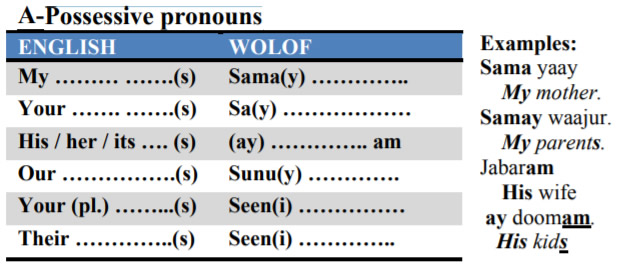Difference between revisions of "Language/Wolof/Grammar/Possessive-pronouns"
| Line 1: | Line 1: | ||
[[File:Wolof-Language-PolyglotClub.jpg|thumb]] | |||
<div style="font-size:300%;"> Possessive Pronouns in Wolof </div> | <div style="font-size:300%;"> Possessive Pronouns in Wolof </div> | ||
In this lesson we will introduce some grammar points, the first of them will be the POSSESSIVE PRONOUNS. | In this lesson we will introduce some grammar points, the first of them will be the POSSESSIVE PRONOUNS. | ||
[[File:Wolof-Possessive-Pronouns-PolyglotClub.jpg]] | [[File:Wolof-Possessive-Pronouns-PolyglotClub.jpg]] | ||
Examples: | |||
'''Examples:''' | |||
*Sama yaay My mother. | *Sama yaay My mother. | ||
*Samay waajur. My parents. | *Samay waajur. My parents. | ||
Revision as of 22:27, 16 September 2021
In this lesson we will introduce some grammar points, the first of them will be the POSSESSIVE PRONOUNS.
Examples:
- Sama yaay My mother.
- Samay waajur. My parents.
- Jabaram His wife
- ay doomam. His kids
Notes
In Wolof, the possessive pronouns are to some points different from the English possessives.
• The first one is the third person (his – her – its) has just 1 translation in Wolof (am) and it is the only possessive Wolof that comes after the noun (xaritam = his/her friend).
• In Wolof, it’s not the noun that takes the sign of plural (s) but it the possessive pronoun that takes it, it is represented by the (y or i) that is added to the possessive: samay waajur = my parents.
• The plural of “his – her – its” that are translated by “am” is “ay”. Both words surround the qualified noun: ay waajuram = his / her parents.
Source
http://publish.illinois.edu/wolof201fall14/files/2014/08/NEW_WOLOF_BOOK.pdf

